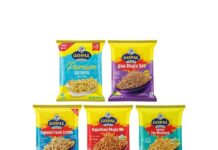
The new HYGiTip powder bag emptying system from Gea is for the safe and efficient opening of 25 kg bags for further processing in food production lines. According to Gea, automation of these steps minimize the risk of contamination, and powder loss is avoided. The new system controls the entire process of opening and emptying, thus ensuring precise repeatability. After emptying, the packaging waste is safely removed and sent for recycling. The HYGiTip is suitable for a variety of products such as milk powder, food supplements, milk and food ingredients, coffee, tea, bakery, and confectionery ingredients, and pet food.
With the increasing demand for ready-to-eat foods, food manufacturers want a higher degree of automation to improve overall efficiency and reduce labor costs. Gea HYGiTip opens up enormous potential, because around 90% of over six million tons of milk powder, which are mainly intended for further processing in the food industry as 25 kg sacks, have been opened by hand so far. The ability to handle bags automatically represents a significant step forward for the food processing industry
Closed, automatic bag emptying system
The HYGiTip is a completely closed system for the automatic emptying of 25 kg powder bags. According to Gea, this enables a high level of hygiene and safety and, thus, product integrity while reducing operating costs. After depalletizing, the full bags are fed manually via a vacuum lifter or automatically by a robot. The outer packaging made of kraft paper is removed manually and forwarded for recycling; the plastic inliner is then sterilized with UV light. The bag is then adjusted, tilted, and its contents placed in the receiving system. The empty inliner is then removed for recycling.
Safe handling and clean cut
Central features of the new HYGiTip are the positive grip mechanism (Gea has applied for a patent), and the clean-cut rotary knives. The positive grip mechanism holds and moves the bag throughout the process. After being securely picked up, the clamping device brings the bag into a vertical position, where it is perforated before it is cut open. This ensures an even pressure distribution inside the bag so that the powder can escape more easily. This handling not only ensures reliable reproducibility but also prevents bag deformation and the remaining powder residues. The pouch is always at a sufficient distance from the powder flow to minimize the risk of contamination.
The clean-cut-system has two toothless, curved cutting knives that cut the bag from the center outwards by rotation. There is no sawing cut because, ultimately, no plastic particles should get into the further production flow. Knives cut the inliner on three sides so that the lower ends of the suspended inliner are spread apart and cut open into the corners. This means that there are no pockets in which powder could remain – this ensures maximum efficiency when emptying.
Preservation of the powder
Kyle Hogarty, product manager-Powder Packing at Gea, states that the traditional cutting and emptying of the powder bags by hand undoubtedly has an adverse effect on further processing or the dry mix. “After filling the sack, the powder is the most valuable – and the most sensitive. Special care is required from then on because, during further processing, the product is exposed to the greatest risk of contamination by foreign bodies and pathogens, at least if the further handling, including the cutting of the bags, is carried out manually by operating personnel. Our new HYGiTip system eliminates this risk and improves the efficiency of the entire system,” says Hogarty.
Headquartered in Düsseldorf, Germany, Gea is the international technology group specializing in machinery, plants, and process technology and components. Today, GEA is a globally active and leading company, known for its leading technologies worldwide, particularly for the food industry. The group generates around 70% of its revenue in the food and beverage sector that enjoys long-term sustainable growth.
IndiFoodBev — authentic, impactful and influential
An English-language food and beverage processing and packaging industry B2B platform in print and web, IndiFoodBev is in its third year of publication. It is said that the Indian food and beverage industries represent approximately US$ 900 billion in revenues which implies more than 20% of the country’s GDP. Eliminating the wastage on the farmside can help to deliver more protein to a higher number of the population apart from generating sizable exports. The savings in soil, seeds, water, fertilizer, energy and ultimately food and nutrition could be the most immense contribution that country is poised to make to the moderation of climate change.
To improve your marketing and grow sales to the food and beverage processing and packaging industry, talk to us. Our research and consulting company IppStar [www.ippstar.org] can assess your potential and addressable markets in light of the competition. We can discuss marketing, communication, and sales strategies for market entry and growth.
Suppliers and service providers with a strategy and budget for targeted marketing can discuss using our hybrid print, web, video, and social media channels to create brand recognition linked to market relevance. Our technical writers are ready to meet you and your customers for content.
The second largest producer of fruit and vegetables in the world is continuously expanding processing capacities and delivery systems with appropriate innovative technologies. We cover product and consumer trends, nutrition, processing, research, equipment and packaging from farm to thali. Get our 2025 media kit and recalibrate your role in this dynamic market. Enhance your visibility and relevance to existing markets and turn potential customers into conversations. Ask for a sample copy of our bi-monthly in print or our weekly IndiFoodBev eZine each Wednesday.
For editorial info@ippgroup.in — for advertisement ads1@ippgroup.in and for subscriptions subscription@ippgroup.in
Naresh Khanna – 10 February 2025
Subscribe Now










